Diterpenoid alkaloids are natural compounds having complex structural features with many stereo-centres originating from the amination of natural tetracyclic diterpenes and produced primarily from plants in the Aconitum, Delphinium, Consolida genera. Corals, Xenia, Okinawan/Clavularia, Alcyonacea (soft corals) and marine sponges are rich sources of diterpenoids, despite the difficulty to access them and the lack of availability. Researchers have long been concerned with the potential beneficial or harmful effects of diterpenoid alkaloids due to their structural complexity, which accounts for their use as pharmaceuticals as well as their lousy reputation as toxic substances. Compounds belonging to this unique and fascinating family of natural products exhibit a broad spectrum of biological activities. Some of these compounds are on the list of clinical drugs, while others act as incredibly potent neurotoxins. Despite numerous attempts to prepare synthetic products, this review only introduces the natural diterpenoid alkaloids, describing ‘compounds’ structures and classifications and their toxicity and bioactivity. The purpose of the review is to highlight some existing relationships between the presence of substituents in the structure of such molecules and their recognised bioactivity.
- diterpenoid alkaloids
- Consolida
- marine sponges
- toxicity
1. Introduction
2. Classification of Diterpenoid Alkaloids
2.1. C18-Diterpenoid Alkaloids
2.1.1. Ranaconitine Group
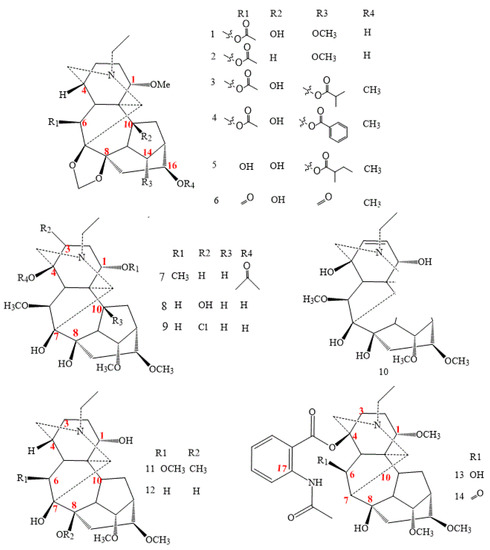
2.1.2. Lappaconitine Group
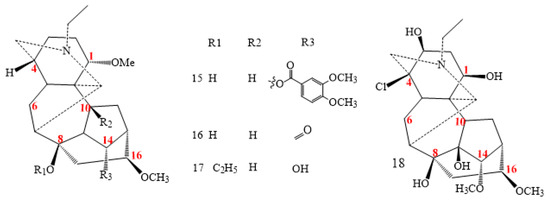
2.1.3. Rearranged Group

2.2. C19-Diterpenoid Alkaloids
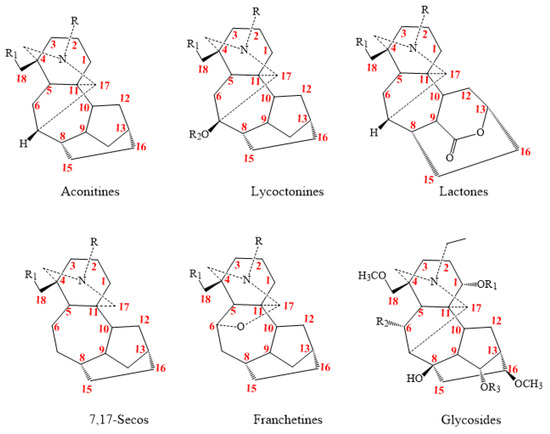
2.2.1. C19-Aconitine Class
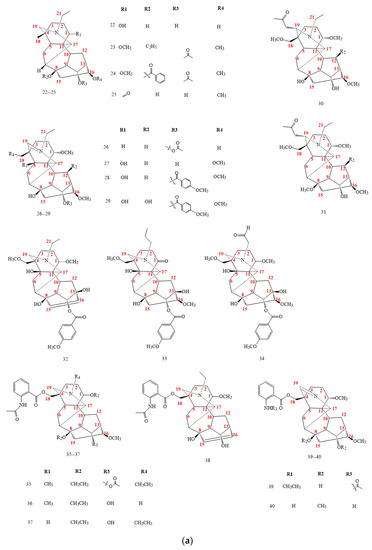
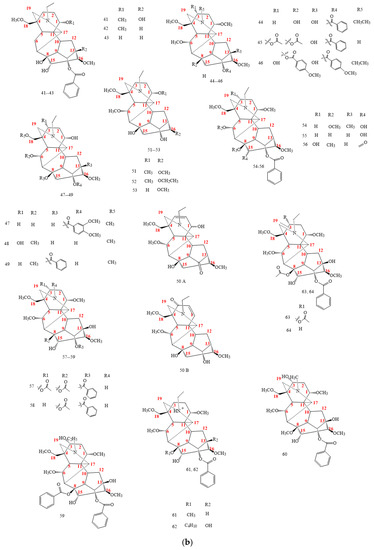
2.2.2. C19-Lycoctonine Class
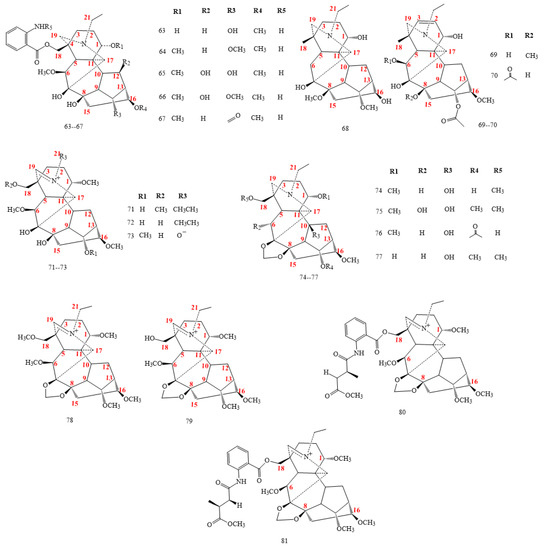
- (i)
- (ii)
-
Many alkaloids contain only the common oxygenated groups, e.g., methoxyl and hydroxyl group(s). In most cases, the methoxyl groups locate at C1, C16, and C18. The hydroxyl groups mainly located at C8 and C14. The presence of hydroxyl groups at C3, C10, C13, and C15 may lead to their structural diversity [53][54][63].
- (iii)
- (iv)
-
They contain an N-ethyl structural unit. Very few alkaloids possess an N-methyl group [33].
- (v)
-
The oxygenated substituents at the C1, C6, and C15 positions of the alkaloids possess an a-orientation in most cases [42].
2.2.3. C19-Lactone Class

2.2.4. C19-7,17-Seco Class

2.2.5. C19-Franchetine Class

2.2.6. C19-DA Glycosides

2.2.7. C19-DA Rearranged Class
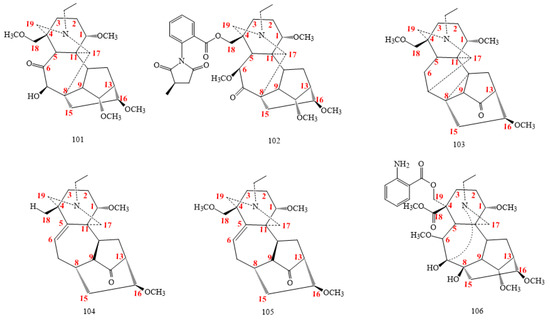
2.3. C20-Diterpenoid Alkaloids
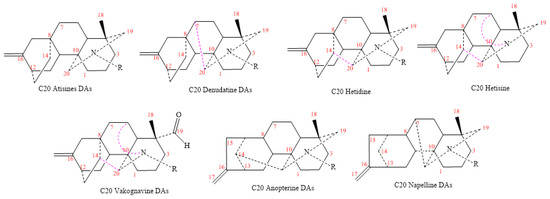
2.3.1. C20-Atisines Class
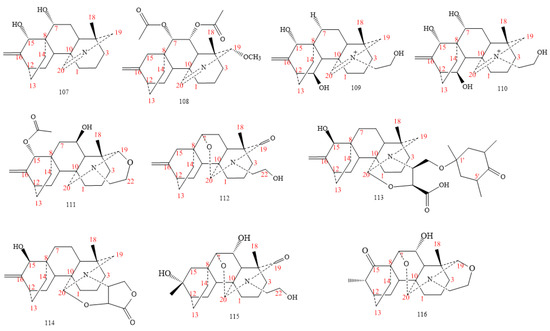
2.3.2. C20-Denudatine Class
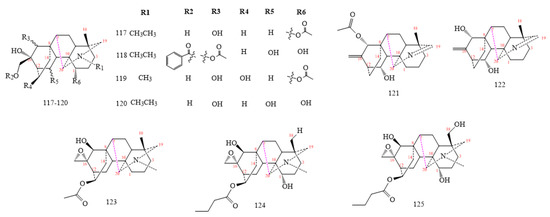
2.3.3. C20-Hetisine Class
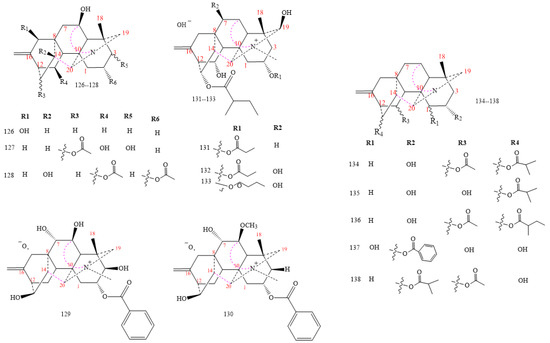
2.3.4. C20-Hetidine Class
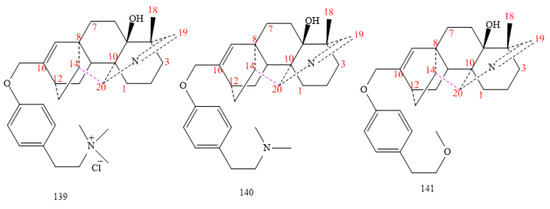
2.3.5. C20-Vakognavine Class
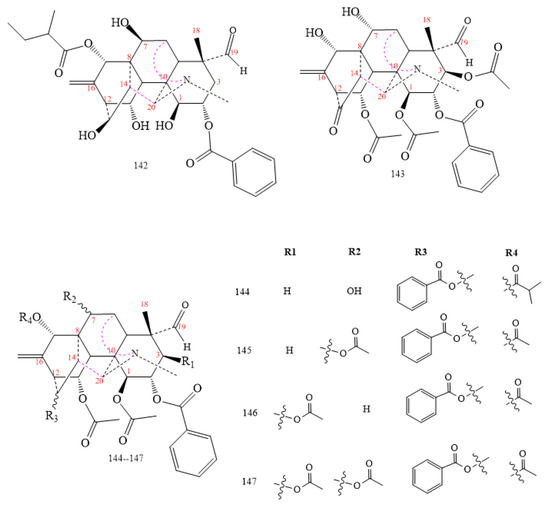
2.3.6. C20-Napelline Class
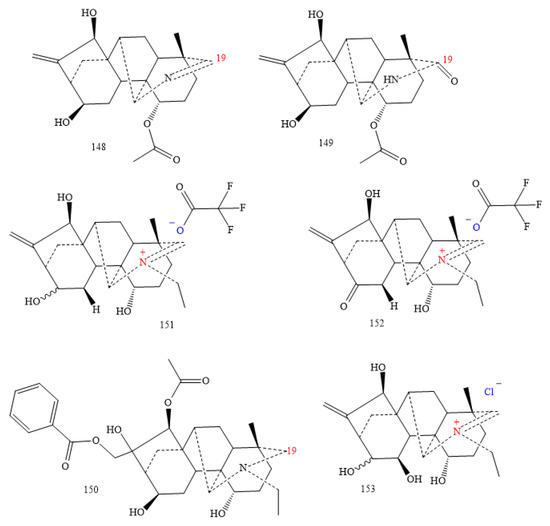
2.3.7. C20-Anopterine Class

2.3.8. C20-Rearranged Classes

- (i)
-
Most of them do not contain a methoxy group in their structures as C19-DAs [108];
- (ii)
- (iii)
- (iv)
2.4. Bis-Diterpenoid Alkaloids
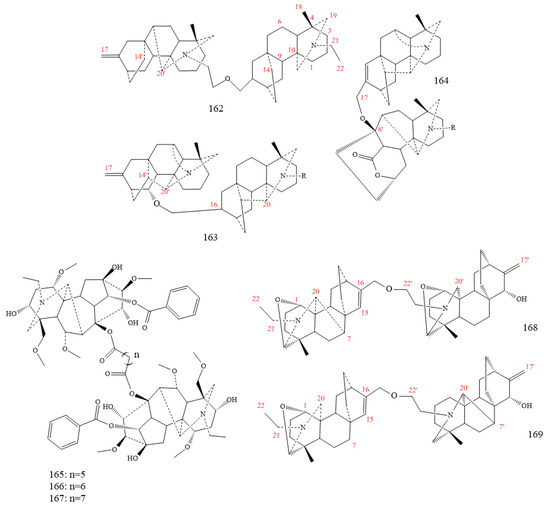
3. Marine Diterpenoid
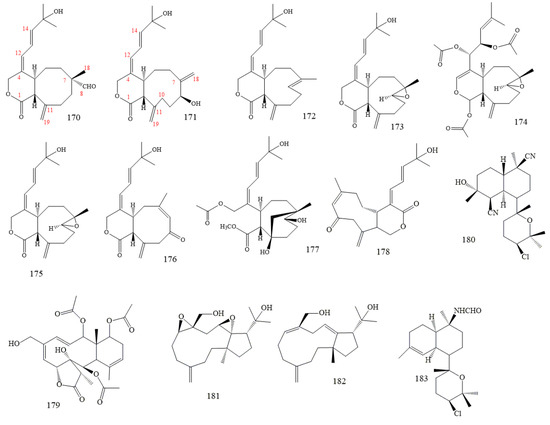
4. Toxicity
5. Bio-Activities of DAs
5.1. Analgesic Activities
5.2. Anti-Inflammatory Activities
5.3. Antimicrobial Activities
5.4. Antioxidant Activities
5.5. Cytotoxic Activity
6. Conclusions
References
- Xiao, P.-G. A pharmacophylogenetic study of Aconitum L. (Ranunculaceae) from China. Acta Phytotaxon Sin. 2006, 44, 3–48.
- Yin, T.; Zhou, H.; Cai, L.; Ding, Z. Non-alkaloidal constituents from the genus Aconitum: A review. RSC Adv. 2019, 9, 10184–10194.
- Shen, Y.; Zuo, A.X.X.; Jiang, Z.Y.; Zhang, X.M.; Wang, H.L.; Chen, J.J. Five New C19-Diterpenoid Alkaloids from Aconitum hemsleyanum. Helv. Chim. Acta 2010, 93, 482–489.
- Kiss, T.; Cank, K.; Orbán-Gyapai, O.; Liktor-Busa, E.; Rutkovska, S.; Pučka, I.; Hohmann, J.; Csupor, D. Screening for diterpene alkaloids in the Spiraea genus. Planta Med. 2015, 81, PM_19.
- Wang, F.P.; Chen, Q.H.; Liang, X.T. Alkaloids toxic to livestock. In The Alkaloids: Chemistry and Biology; Cordell, G.A., Ed.; Elsevier Science: New York, NY, USA, 2009; Volume 67, pp. 1–282.
- Wang, F.P.; Chen, Q.H. The C19-Diterpenoid alkaloids. In The Alkaloids: Chemistry and Biology; Cordell, G.A., Ed.; Elsevier Science: New York, NY, USA, 2010; Volume 69, pp. 1–609.
- Wang, F.P.; Liang, X.T. C20-Diterpenoid alkaloids. In The Alkaloids: Chemistry and Biology; Cordell, G.A., Ed.; Elsevier Science: New York, NY, USA, 2002; Volume 59, pp. 1–280.
- Wang, F.-P.; Chen, Q.-H.; Liu, X.-Y. Diterpenoid alkaloids. Nat. Prod. Rep. 2010, 27, 529–570.
- Hao, D.C.; Gu, X.J.; Xiao, P.G. Medicinal Plants: Chemistry, Biology and Omics, 1st ed.; Woodhead Publishing: Sawston, Cam-bridge, MA, USA, 2015; pp. 253–292.
- Ameri, A. The effects of Aconitum-alkaloids on the central nervous system. Prog. Neurobiol. 1998, 56, 211–235.
- Bessonova, I.A.; Saidkhodzhaeva, S.A. Hetisane—Type Diterpenoid Alkaloids. Chem. Nat. Compd. 2000, 36, 419–477.
- Pelletier, S.W.; Joshi, B.S. Carbon-13 and Proton NMR Shift Assignments and Physical Constants of Norditerpenoid Alkaloids. In Alkaloids: Chemical and Biological Perspectives, 1st ed.; Pergamon: New York, NY, USA, 2001; pp. 297–564.
- Joshi, B.S.; Pelletier, S.W.; Srivastava, S.K. Carbon-13 and proton NMR shift assignments and physical constants of diterpenoid alkaloids. In Alkaloids: Chemical and Biological Perspectives, 1st ed.; Pergamon: New York, NY, USA, 1999; p. 289.
- Hale, K.J.; Manaviazar, S. Second Supplements to the 2nd Edition of ‘ ‘Rodd’s Chemistry of Carbon Compounds; Sainsbury, M., Ed.; Elsevier: Amsterdam, The Netherlands, 1991; p. 1.
- Rahman, A.-U.; Choudhary, M.I. Diterpenoid and steroidal alkaloids. Nat. Prod. Rep. 1999, 16, 619–635.
- Ping, A.; Chen, Q.H.; Chen, D.L.; Jian, X.X.; Wang, F.P. Note: Two new C19-diterpenoid alkaloids from Aconitum kongboense. J. Asian Nat. Prod. Res. 2004, 6, 151–154.
- Peng, C.S.; Wang, F.P.; Wang, J.Z.; Jian, X.X. Two new bisnorditerpenoid alkaloids sinomontanines D and E from Aconitum sinomontanum. Acta Pharm. Sin. B 2000, 35, 201–203.
- Zou, C.-L.; Cai, L.; Ji, H.; Xie, G.-B.; Wang, F.-P.; Jian, X.-X.; Song, L.; Liu, X.-Y.; Chen, D.-L.; Chen, Q.-H. A novel approach to the taxane ABC ring system through chemical conversion from C19-diterpenoid alkaloid deltaline. Tetrahedron 2008, 64, 7594–7604.
- Lin, L.; Chen, D.L.; Liu, X.Y.; Chen, Q.H.; Wang, F.P. Trichocarpinine, a novel hetidine–hetisine type bisditerpenoid alkaloid from Aconitum tanguticum var. trichocarpum. Helv. Chim. Acta 2010, 93, 118–122.
- Meng, X.H.; Guo, Q.L.; Zhu, C.G.; Xu, C.B.; Shi, J.G. Unprecedented, C19-diterpenoid alkaloid glycosides from an aqueous extract of “Fu Zi”: Neoline 14-O-l-arabinosides with four isomeric l-anabinosyls. Chin. Chem. Lett. 2017, 28, 1705–1710.
- Guo, Q.; Xia, H.; Meng, X.; Shi, G.; Xu, C.; Zhu, C.; Zhang, T.; Shi, J. C19-Diterpenoid alkaloid arabinosides from an aqueous extract of the lateral root of Aconitum carmichaelii and their analgesic activities. Acta Pharm. Sin. B 2018, 8, 409–419.
- Song, L.; Liu, X.-Y.; Chen, Q.-H.; Wang, F.-P. New C19- and C18-Diterpenoid Alkaloids from Delphinium anthriscifolium var. savatieri. Chem. Pharm. Bull. 2009, 57, 158–161.
- Song, Z.-J.; Chen, W.-Q.; Du, X.-Y.; Yuan, Y.-F.; Xu, H.-H. Anthriscifolcine A, a C18-diterpenoid alkaloid. Acta Crystallogr. Sect. E Struct. Rep. Online 2011, 67, o395.
- Shan, L.-H.; Zhang, J.-F.; Gao, F.; Huang, S.; Zhou, X.-L. C18-Diterpenoid alkaloids from Delphinium anthriscifolium var. majus. J. Asian Nat. Prod. Res. 2017, 20, 423–430.
- Shan, L.; Zhang, J.; Chen, L.; Wang, J.; Huang, S.; Zhou, X. Two New C18-Diterpenoid Alkaloids from Delphinium anthriscifolium. Nat. Prod. Commun. 2015, 10, 2067–2068.
- Zhang, S.-Y.; Jiang, Y.; Bi, Y.-F.; Yan, W.-J.; Zhang, Y.-B. Diterpenoid alkaloids from Aconitum kirinense. J. Asian Nat. Prod. Res. 2013, 15, 78–83.
- Mu, Z.-Q.; Gao, H.; Huang, Z.-Y.; Feng, X.-L.; Yao, X.-S. Puberunine and Puberudine, Two New C18-Diterpenoid Alkaloids from Aconitum barbatum var. puberulum. Org. Lett. 2012, 14, 2758–2761.
- Li, J.; Chang, H.; Zhao, W.; Pi, H.; Ruan, H.; Zhang, P. New Alkaloids from Aconitum vaginatum. Helv. Chim. Acta 2014, 97, 689–693.
- Sham’Yanov, I.D.; Tashkhodzhaev, B.; Mukhamatkhanova, R.F.; Sultankhodzhaev, M.N.; Levkovich, M.G.; Abdullaev, N.; Antipin, M.Y. Sesquiterpene lactones and new diterpenoid alkaloids from Artemisia korshinskyi. Chem. Nat. Compd. 2012, 48, 616–621.
- Zhao, D.-K.; Ai, H.-L.; Zi, S.-H.; Zhang, L.-M.; Yang, S.-C.; Guo, H.-C.; Shen, Y.; Chen, Y.-P.; Chen, J.-J. Four new C18-diterpenoid alkaloids with analgesic activity from Aconitum weixiense. Fitoterapia 2013, 91, 280–283.
- Zhang, Q.; Tan, J.J.; Chen, X.Q.; Gao, Z.B.; Jia, Q.; Chen, K.X.; Li, Y.M. Two novel C18-diterpenoid alkaloids, sinomon-tadine with an unprecedented seven-membered ring A and chloride-containing sinomontanine N from Aconitum sinomon-tanum. Tetrahedron Lett. 2017, 58, 1717–1720.
- Shen, Y.; Ai, H.-L.; Cao, T.-W.; Wang, J.-J.; Zi, S.-H.; Zhang, X.-M.; Chen, J.-J. Three New C19-Diterpenoid Alkaloids from Aconitum transsectum. Helv. Chim. Acta 2012, 95, 509–513.
- Shen, Y.; Ai, H.L.L.; Zi, S.H.H.; Wang, J.J.; Zhang, X.M.; Chen, J.J. Two new C19-diterpenoid alkaloids from Aconitum transsectum. J. Asian Nat. Prod. Res. 2012, 14, 244–248.
- Xu, J.-J.; Zhao, D.-K.; Ai, H.-L.; Zhang, L.-M.; Xie, S.-Q.; Zi, S.-H.; Yang, S.-C.; Shen, Y. Three New C19-Diterpenoid Alkaloids from Aconitum forrestii. Helv. Chim. Acta 2013, 96, 2155–2159.
- Tianxing, T.; Donglin, C.; Fengpeng, W. A New C19-Diterpenoid Alkaloid from Aconitum vilmorinianum. Chin. J. Org. Chem. 2014, 34, 909–915.
- Yin, T.-P.; Cai, L.; Li, Y.; Fang, Y.-S.; Peng, L.; Ding, Z.-T. New Alkaloids from Aconitum stapfianum. Nat. Prod. Bioprospecting 2015, 5, 271–275.
- Guo, R.; Guo, C.; He, D.; Zhao, D.; Shen, Y. Two New C19-Diterpenoid Alkaloids with Anti-inflammatory Activity from Aconitum iochanicum. Chin. J. Chem. 2017, 35, 1644–1647.
- Xu, J.-B.; Huang, S.; Zhou, X.-L. C19-diterpenoid alkaloids from Aconitum hemsleyanum var. circinatum. Phytochem. Lett. 2018, 27, 178–182.
- He, P.; Jian, X.-X.; Chen, D.-L.; Wang, F.-P. Diterpenoid Alkaloids from Aconitum longzhoushanense. Nat. Prod. Commun. 2009, 4, 19–22.
- Chen, C.L.; Tan, W.H.; Wang, Y.; Xue, Z.G.; Wan, C.P.; Yang, Z.Y.; Zhou, Z.H.; Ma, X.X.X. New norditerpenoid alkaloids from Aconitum vilmorinianum Komarov. J. Nat. Med. 2015, 69, 601–607.
- Liu, W.Y.; He, D.; Zhao, D.K.; Chen, Y.P.; Shen, Y. Four new C19-diterpenoid alkaloids from the roots of Aconitum ouvrardianum. J. Asian Nat. Prod. Res. 2019, 21, 9–16.
- He, D.; Liu, W.-Y.; Xiong, J.; Xu, J.-J.; Shen, Y. Four new C19-diterpenoid alkaloids from Aconitum hemsleyanum var. circinatum. J. Asian Nat. Prod. Res. 2018, 21, 833–841.
- Ge, Y.H.H.; Mu, S.Z.Z.; Yang, S.Y.; Lu, Y.; Zhang, J.X.; Wang, Y.; Hao, X.J. New Diterpenoid Alkaloids from Aconitum recemulosum Franch. Helv. Chim. Acta 2009, 92, 1860–1865.
- Gao, F.; Zhu, S.-A.; Wu, W.; Wang, X.-G.; Song, L. C19-Diterpenoid alkaloids from the roots of Aconitum hemsleyanum var. hanyuanum and their chemotaxonomic significance. Biochem. Syst. Ecol. 2010, 38, 1052–1055.
- Gao, F.; Liu, X.Y.; Wang, F.P. Three New C19-Diterpenoid Alkaloids from Aconitum hemsleyanum var. circinatum. Helv. Chim. Acta 2010, 93, 785–790.
- Forgo, P.; Borcsa, B.; Csupor, D.; Fodor, L.; Berkecz, R.; Molnár, A.; Hohmann, J. Diterpene alkaloids from Aconitum anthora and assessment of the hERG-inhibiting ability of Aconitum alkaloids. Planta Med. 2011, 77, 368–373.
- Song, B.; Jin, B.; Li, Y.; Wang, F.; Yang, Y.; Cui, Y.; Song, X.; Yue, Z.; Liu, J. C19-Norditerpenoid Alkaloids from Aconitum szechenyianum. Molecules 2018, 23, 1108.
- Li, G.-Q.; Zhang, L.-M.; Zhao, D.-K.; Chen, Y.-P.; Shen, Y. Two new C19-diterpenoid alkaloids from Aconitum tsaii. J. Asian Nat. Prod. Res. 2016, 19, 457–461.
- Zhang, J.-F.; Chen, L.; Huang, S.; Shan, L.-H.; Gao, F.; Zhou, X.-L. Diterpenoid Alkaloids from Two Aconitum Species with Antifeedant Activity against Spodoptera exigua. J. Nat. Prod. 2017, 80, 3136–3142.
- Jiang, H.; Huang, S.; Gao, F.; Zhen, Y.; Li, C.; Zhou, X. Diterpenoid alkaloids from Aconitum brevicalcaratum as autophagy inducers. Nat. Prod. Res. 2019, 33, 1741–1746.
- Zhao, D.; Shi, Y.; Zhu, X.; Liu, L.; Ji, P.; Long, C.; Shen, Y.; Kennelly, E.J. Identification of potential biomarkers from Aconitum carmichaelii, a traditional Chinese medicine, using a metabolomic approach. Planta Med. 2018, 84, 434–441.
- Zong, X.-X.; Yan, G.; Wu, J.-L.; Leung, E.L.-H.; Zhou, H.; Li, N.; Liu, L. New C19-diterpenoid alkaloids from the parent roots of Aconitum carmichaelii. Tetrahedron Lett. 2017, 58, 1622–1626.
- Yamashita, H.; Takeda, K.; Haraguchi, M.; Abe, Y.; Kuwahara, N.; Suzuki, S.; Terui, A.; Masaka, T.; Munakata, N.; Uchida, M.; et al. Four new diterpenoid alkaloids from Aconitum japonicum subsp. subcuneatum. J. Nat. Med. 2017, 72, 230–237.
- Yang, L.; Zhang, Y.-B.; Zhuang, L.; Li, T.; Chen, N.-H.; Wu, Z.-N.; Wang, G.-C. Diterpenoid Alkaloids from Delphinium ajacis and Their Anti-RSV Activities. Planta Med. 2016, 83, 111–116.
- Begum, S.; Mumtaz, A.; Latif, A.; Ahmad, W.; Alam, S.; Nisar, M.; Zeeshan, M.; Khan, M.T.H.; Shaheen, F.; Ahmad, M. Pharmacologically active C19-diterpenoid alkaloids from the aerial parts of Aconitum laeve Royle. Rec. Nat. Prod. 2014, 8, 83–88.
- Chen, F.-Z.; Chen, D.-L.; Chen, Q.-H.; Wang, F.-P. Diterpenoid Alkaloids from Delphinium majus. J. Nat. Prod. 2009, 72, 18–23.
- Chen, F.-Z.; Chen, Q.-H.; Wang, F.-P. C19-Diterpenoid alkaloids from Delphinium umbrosum. J. Asian Nat. Prod. Res. 2010, 12, 498–504.
- Zhang, J.F.; Shan, L.H.; Gao, F.; Huang, S.; Zhou, X.L. Five New C19-Diterpenoid Alkaloids from Delphinium tianshanicum WT Wang. Chem. Biodivers. 2017, 14, e1600297.
- Zhao, B.; Usmanove, S.; Aisa, H.A.A. Three new C19-diterpenoid alkaloids from Delphinium tianshanicum WT Wang. Phytochem. Lett. 2014, 10, 189.
- Shan, L.; Chen, L.; Gao, F.; Zhou, X. Diterpenoid alkaloids from Delphinium naviculare var. lasiocarpum with their an-tifeedant activity on Spodoptera exigua. Nat. Prod. Res. 2019, 33, 3254–3259.
- Wada, K.; Chiba, R.; Kanazawa, R.; Matsuoka, K.; Suzuki, M.; Ikuta, M.; Goto, M.; Yamashita, H.; Lee, K.H. Six new norditerpenoid alkaloids from Delphinium elatum. Phytochem. Lett. 2015, 12, 79–83.
- Borcsa, B.; Fodor, L.; Csupor, D.; Forgo, P.; Molnár, A.; Hohmann, J. Diterpene Alkaloids from the Roots of Aconitum moldavicum and Assessment of Nav 1.2 Sodium Channel Activity of Aconitum Alkaloids. Planta Med. 2014, 80, 231–236.
- Xue, W.J.; Zhao, B.; Ruzi, Z.; Zhao, J.Y.; Aisa, H.A.A. Norditerpenoid alkaloids from Delphinium pseudoaemulans C.Y. Yang et B. Wang. Phytochemistry 2018, 156, 234–240.
- Morita, H.; Aisa, H.A.; Li, C.; Hirasawa, Y.; Arai, H. A New Diterpenoid Alkaloid, Sharwuphinine A from Delphinium sharwurense. Heterocycles 2010, 80, 607.
- Tashkhodzhaev, B. Conformational analysis of lappaconitine and heteratisine. Chem. Nat. Compd. 2010, 46, 421–425.
- Zhou, X.; Frejat, F.O.A.; Xu, W.; Shan, L. Three New Lactone-Type Diterpenoid Alkaloids from Aconitum rotundifolium Kar. & Kir. Heterocycles 2017, 94, 1903.
- Ahmad, H.; Ahmad, S.; Shah, S.A.A.; Latif, A.; Ali, M.; Khan, F.A.; Tahir, M.N.; Shaheen, F.; Wadood, A.; Ahmad, M. Antioxidant and anticholinesterase potential of diterpenoid alkaloids from Aconitum heterophyllum. Bioorganic Med. Chem. 2017, 25, 3368–3376.
- Wang, Y.-J.; Zhang, J.; Zeng, C.-J.; Yao, Z.; Zhang, Y. Three new C19-diterpenoid alkaloids from Aconitum pendulum. Phytochem. Lett. 2011, 4, 166–169.
- Shen, Y.; Zuo, A.X.X.; Jiang, Z.Y.; Zhang, X.M.; Wang, H.L.; Chen, J.J. Four New Nor-Diterpenoid Alkaloids from Aconitum brachypodum. Helv. Chim. Acta 2010, 93, 863–869.
- Wang, F.; Yue, Z.; Xie, P.; Zhang, L.; Li, Z.; Song, B.; Tang, Z.; Song, X. C19-Norditerpenoid Alkaloids from Aconitum szechenyianum and Their Effects on LPS-Activated NO Production. Molecules 2016, 21, 1175.
- Li, Y.; Gao, F.; Zhang, J.-F.; Zhou, X.-L. Four New Diterpenoid Alkaloids from the Roots of Aconitum carmichaelii. Chem. Biodivers. 2018, 15, e1800147.
- Wang, D.-P.; Lou, H.-Y.; Huang, L.; Hao, X.-J.; Liang, G.-Y.; Yang, Z.-C.; Pan, W.-D. A novel franchetine type norditerpenoid isolated from the roots of Aconitum carmichaeli Debx. with potential analgesic activity and less toxicity. Bioorganic Med. Chem. Lett. 2012, 22, 4444–4446.
- Sun, L.-M.; Huang, H.-L.; Li, W.-H.; Nan, Z.-D.; Zhao, G.-X.; Yuan, C.-S. ChemInform Abstract: Alkaloids from Aconitum barbatum var. puberulum. Helv. Chim. Acta 2009, 40, 1126–1133.
- Shen, Y.; Zuo, A.-X.; Jiang, Z.-Y.; Zhang, X.-M.; Wang, H.-L.; Chen, J.-J. Hemsleyaconitines F and G, Two Novel C19-Diterpenoid Alkaloids Possessing a Unique Skeleton from Aconitum hemsleyanum. Helv. Chim. Acta 2011, 94, 268–272.
- Chen, F.-Z.; Chen, Q.-H.; Wang, F.-P. Diterpenoid Alkaloids from Delphinium yunnanense. Helv. Chim. Acta 2011, 94, 254–260.
- Chen, N.-H.; Zhang, Y.-B.; Li, W.; Li, P.; Chen, L.-F.; Li, Y.-L.; Li, G.-Q.; Wang, G.-C. Grandiflodines A and B, two novel diterpenoid alkaloids from Delphinium grandiflorum. RSC Adv. 2017, 7, 24129–24132.
- Ma, Y.; Mao, X.Y.; Huang, L.J.; Fan, Y.M.M.; Gu, W.; Yan, C.; Huang, T.; Zhang, J.X.; Yuan, C.M.; Hao, X.J. Diterpene alka-loids and diterpenes from Spiraea japonica and their anti-tobacco mosaic virus activity. Fitoterapia 2016, 109, 8–13.
- Nisar, M.; Obaidullah Ahmad, M.; Wadood, N.; Lodhi, M.A.A.; Shaheen, F.; Choudhary, M.I. New diterpenoid alkaloids from Aconitum heterophyllum Wall: Selective butyrylcholinestrase inhibitors. J. Enzyme Inhib. Med. Chem. 2009, 24, 47–51.
- He, Y.Q.; Ma, Z.Y.; Wei, X.M.; Liu, D.J.; Du, B.Z.; Yao, B.H.; Gao, L.M. Honatisine, a Novel Diterpenoid Alkaloid, and Six Known Alkaloids from Delphinium honanense and Their Cytotoxic Activity. Chem. Biodivers. 2011, 8, 2104–2109.
- He, Y.Q.; Ma, Z.Y.; Wei, X.M.; Du, B.Z.; Jing, Z.X.; Yao, B.H.; Gao, L.M. Chemical constituents from Delphinium chrysotrichum and their biological activity. Fitoterapia 2010, 81, 929–931.
- Liu, X.Y.; Chen, Q.H.; Wang, F.P. Three new C20-diterpenoid alkaloids from Delphinium anthriscifolium var. savatieri. Chin. Chem. Lett. 2009, 20, 698–701.
- Shen, Y.; Zuo, A.-X.; Jiang, Z.-Y.; Zhang, X.-M.; Wang, H.-L.; Chen, J.-J. Two New Diterpenoid Alkaloids from Aconitum brachypodum. Bull. Korean Chem. Soc. 2010, 31, 3301–3303.
- Wada, K.; Kawahara, N. Diterpenoid and norditerpenoid alkaloids from the roots of Aconitum yesoense var. macroyesoense. Helv. Chim. Acta 2009, 92, 629–637.
- Yang, L.-G.; Zhang, Y.-J.; Xie, J.-Y.; Xia, W.-J.; Zhang, H.-Y.; Tang, M.-Y.; Mei, S.-X.; Cui, T.; Wang, J.-K.; Zhu, Z.-Y. Diterpenoid alkaloids from the roots of Aconitum brachypodum Diels. J. Asian Nat. Prod. Res. 2016, 18, 908–912.
- Xiong, L.; Peng, C.; Xie, X.-F.; Guo, L.; He, C.-J.; Geng, Z.; Wan, F.; Dai, O.; Zhou, Q.-M. Alkaloids Isolated from the Lateral Root of Aconitum carmichaelii. Molecules 2012, 17, 9939–9946.
- Tang, H.; Wen, F.L.; Wang, S.H.; Liu, X.Y.; Chen, D.L.; Wang, F.P. New C20-diterpenoid alkaloids from Aconitum sinomontanum. Chin. Chem. Lett. 2016, 27, 761–763.
- Samanbay, A.; Zhao, B.; Aisa, H.A. A new denudatine type C20-diterpenoid alkaloid from Aconitum sinchiangense WT Wang. Nat. Prod. Res. 2018, 32, 2319–2324.
- Chen, L.; Shan, L.; Xu, W.; Zhang, J.; Huang, S.; Zhou, X. A new C20-diterpenoid alkaloid from Aconitum soongaricum var. pubescens. Nat. Prod. Res. 2017, 31, 523–528.
- Shen, Y.; Zuo, A.X.X.; Jiang, Z.Y.; Zhang, X.M.; Wang, H.L.; Chen, J.J. Two New C20-Diterpenoid Alkaloids from Aconitum carmichaelii. Helv. Chim. Acta 2011, 94, 122–126.
- Zhang, Z.-T.; Liu, X.-Y.; Chen, D.-L.; Wang, F.-P. New Diterpenoid Alkaloids from Aconitum liangshanicum. Helv. Chim. Acta 2010, 93, 811–817.
- Yin, T.P.; Cai, L.; Xing, Y.; Yu, J.; Li, X.J.J.; Mei, R.F.; Ding, Z.T. Alkaloids with antioxidant activities from Aconitum handelianum. J. Asian Nat. Prod. Res. 2016, 18, 603–610.
- Zhao, D.-K.; Shi, X.-Q.; Zhang, L.-M.; Yang, D.-Q.; Guo, H.-C.; Chen, Y.-P.; Shen, Y. Four new diterpenoid alkaloids with antitumor effect from Aconitum nagarum var. heterotrichum. Chin. Chem. Lett. 2017, 28, 358–361.
- Chen, F.-Z.; Chen, Q.-H.; Liu, X.-Y.; Wang, F.-P. Diterpenoid Alkaloids from Delphinium tatsienense. Helv. Chim. Acta 2011, 94, 853–858.
- Tang, T.X.; Chen, Q.F.; Liu, X.Y.; Jian, X.X.; Wang, F.P. New C20-diterpenoid alkaloids from Aconitum vilmorrianum and structural revision of 2-O-acetylorochrine and orochrine. J. Asian Nat. Prod. Res. 2016, 18, 315–327.
- Tang, Q.-F.; Ye, W.-C.; Liu, J.-H.; Yang, C. Three new hetisine-type diterpenoid alkaloids from Aconitum coreanum. Phytochem. Lett. 2012, 5, 397–400.
- Lin, C.-Z.; Zhao, Z.-X.; Xie, S.-M.; Mao, J.-H.; Zhu, C.-C.; Li, X.-H.; Bairi, Z.-D.; Kangsa, S.-Q.; Dun, Z.; Xiong, T.-Q.; et al. Diterpenoid alkaloids and flavonoids from Delphinium trichophorum. Phytochemistry 2014, 97, 88–95.
- Xing, B.N.; Jin, S.S.; Wang, H.; Tang, Q.F.; Liu, J.H.; Li, R.Y.Y.; Liang, J.Y.; Tang, Y.Q.; Yang, C.H. New diterpenoid alka-loids from Aconitum coreanum and their antiarrhythmic effects on cardiac sodium current. Fitoterapia 2014, 94, 120–126.
- Gabbasov, T.M.; Tsyrlina, E.M.; Anatov, D.M.; Spirikhin, L.V.; Yunusov, M.S. Flexiosine, a New C20-Diterpene Alkaloid from Roots of Delphinium flexuosum. Chem. Nat. Compd. 2017, 53, 105–108.
- Zhang, J.F.; Li, Y.; Gao, F.; Shan, L.H.; Zhou, X.L. Four new C20-diterpenoid alkaloids from Aconitum rotundifolium. J. Asian Nat. Prod. Res. 2019, 21, 716–724.
- Zhang, Z.-T.; Liu, X.-Y.; Chen, D.-L.; Wang, F.-P. Three New C20-Diterpenoid Alkaloids from Aconitum tanguticum var. trichocarpum. Nat. Prod. Commun. 2015, 10, 861–862.
- He, J.-B.; Luan, J.; Lv, X.-M.; Rui, D.-Y.; Tao, J.; Wang, B.; Niu, Y.-F.; Ju, H.-P. Navicularines A–C: New diterpenoid alkaloids from Aconitum naviculare and their cytotoxic activities. Fitoterapia 2017, 120, 142–145.
- Qu, S.-J.; Tan, C.-H.; Liu, Z.-L.; Jiang, S.-H.; Yu, L.; Zhu, D.-Y. Diterpenoid alkaloids from Aconitum tanguticum. Phytochem. Lett. 2011, 4, 144–146.
- Liu, X.Y.; Chen, Q.H.; Wang, F.P. New C20-Diterpenoid Alkaloids from Delphinium anthriscifolium var. savatieri. Helv. Chim. Acta 2009, 92, 745–752.
- Yu, J.; Yin, T.P.; Wang, J.P.; Mei, R.F.; Cai, L.; Ding, Z.T. A new C20-diterpenoid alkaloid from the lateral roots of Aconitum carmichaeli. Nat. Prod. Res. 2017, 31, 228–232.
- Liang, Y.; Wu, J.-L.; Li, X.; Guo, M.-Q.; Leung, E.L.-H.; Zhou, H.; Liu, L.; Li, N. Anti-cancer and anti-inflammatory new vakognavine-type alkaloid from the roots of Aconitum carmichaelii. Tetrahedron Lett. 2016, 57, 5881–5884.
- Yu, H.-J.; Liang, T.-T. A New Alkaloid from the Roots of Aconitum carmichaeli Debx. J. Chin. Chem. Soc. 2012, 59, 693–695.
- Meng, X.H.; Jiang, Z.B.; Zhu, C.G.; Guo, Q.L.; Xu, C.B.; Shi, J.G. Napelline-type C20-diterpenoid alkaloid iminiums from an aqueous extract of “fu zi”: Solvent-/base-/acid-dependent transformation and equilibration between alcohol iminium and aza acetal forms. Chin. Chem. Lett. 2016, 27, 993–1003.
- Levrier, C.; Sadowski, M.C.; Nelson, C.C.; Davis, R.A. Cytotoxic C20-Diterpenoid Alkaloids from the Australian Endemic Rainforest Plant Anopterus macleayanus. J. Nat. Prod. 2015, 78, 2908–2916.
- Nishanov, A.A.; Tashkhodzhaev, B.; Sultankhodzhaev, M.I.; Ibragimov, B.T.; Yunusov, M.S. Alkaloids of the epigeal part of Aconitum talassicum. Structure of actaline. Chem. Nat. Compd. 1989, 25, 32–36.
- Joshi, B.S.; Puar, M.S.; Desai, H.K.; Ross, S.A.; Lu, J.; Pelletier, S.W. The structure of ajabicine, a novel diterpenoid alka-loid from Delphinium ajacis. Tetrahedron Lett. 1993, 34, 1441–1444.
- Chen, L.; Shan, L.; Zhang, J.; Xu, W.; Wu, M.; Huang, S.; Zhou, X. Diterpenoid Alkaloids from Aconitum soongaricum var. pubescens. Nat. Prod. Commun. 2015, 10, 2063–2065.
- Li, Y.; Smolke, C.D. Engineering biosynthesis of the anticancer alkaloid noscapine in yeast. Nat. Commun. 2016, 7, 12137.
- Xie, Y.; Jiang, Z.H.; Zhou, H.; Xu, H.X.; Liu, L. Simultaneous determination of six Aconitum alkaloids in proprietary Chinese medicines by high-performance liquid chromatography. J. Chromatogr. A 2005, 1093, 195–203.
- Nyirimigabo, E.; Xu, Y.; Li, Y.; Wang, Y.; Agyemang, K.; Zhang, Y. A review on phytochemistry, pharmacology and toxicology studies of Aconitum. J. Pharm. Pharmacol. 2015, 67, 1–19.
- Zong, X.; Yan, X.; Wu, J.-L.; Liu, Z.; Zhou, H.; Li, N.; Liu, L. Potentially Cardiotoxic Diterpenoid Alkaloids from the Roots of Aconitum carmichaelii. J. Nat. Prod. 2019, 82, 980–989.
- Tursunkhodzhaeva, F.M.; Dzhakhangirov, F.N.; Salimov, B.T. Diterpenoid alkaloids as antidotes to aconitine-type neu-rotoxin poisoning. Structure–activity relationship. Chem. Nat. Compd. 2016, 52, 849–852.
- Yunusov, M.S. Antiarrhythmic agents based on diterpenoid alkaloids. Russ. Chem. Bull. 2011, 60, 633.
- Dzhakhangirov, F.N.; Kasymova, K.R.; Sultankhodzhaev, M.N.; Salimov, B.T.; Usmanova, S.K.; Shakirov, R.S. Toxicity and local anesthetic activity of diterpenoid alkaloids. Chem. Nat. Compd. 2007, 43, 581–589.
- Chan, T.Y. Aconite poisoning. Clin. Toxicol. 2009, 47, 279–285.
- Chen, S.P.L.; Ng, S.W.W.; Poon, W.T.; Lai, C.K.; Ngan, T.M.S.; Tse, M.L.; Chan, T.Y.K.; Chan, A.Y.W.; Mak, T.W.L. Aconite Poisoning over 5 Years. Drug Saf. 2012, 35, 575–587.
- Li, H.; Liu, L.; Zhu, S.; Liu, Q. Case reports of aconite poisoning in mainland China from 2004 to 2015: A retrospective analysis. J. Forensic Leg. Med. 2016, 42, 68–73.
- Ramawat, K.G.; Mérillon, J.M. (Eds.) Natural Products: Phytochemistry, Botany and Metabolism of Alkaloids, Phenolics and Terpenes; Springer: Heidelberg, Germany, 2013; pp. 1541–2662.
- Daum, G.; Lees, N.D.; Bard, M.; Dickson, R. Biochemistry, cell biology and molecular biology of lipids of Saccharomyces cerevisiae. Yeast 1998, 14, 1471–1510.
- Sun, G.-B.; Sun, H.; Meng, X.-B.; Hu, J.; Zhang, Q.; Liu, B.; Wang, M.; Xu, H.-B.; Sun, X.-B. Aconitine-induced Ca2+ overload causes arrhythmia and triggers apoptosis through p38 MAPK signaling pathway in rats. Toxicol. Appl. Pharmacol. 2014, 279, 8–22.
- Yang, M.; Ji, X.; Zuo, Z. Relationships between the toxicities of Radix Aconiti Lateralis Preparata (Fuzi) and the toxicoki-netics of its main diester-diterpenoid alkaloids. Toxins 2018, 10, 391.
- Ye, Q.; Liu, H.; Fang, C.; Liu, Y.; Liu, X.; Liu, J.; Zhang, C.; Zhang, T.; Peng, C.; Guo, L. Cardiotoxicity evaluation and comparison of diterpene alkaloids on zebrafish. Drug Chem. Toxicol. 2021, 44, 294–301.
- Chen, L.; Yang, J.; Davey, A.K.; Chen, Y.X.; Wang, J.P.; Liu, X.Q. Effects of diammonium glycyrrhizinate on the phar-macokinetics of aconitine in rats and the potential mechanism. Xenobiotica 2009, 39, 955–963.
- Ye, L.; Yang, X.; Yang, Z.; Gao, S.; Yin, T.; Liu, W.; Wang, F.; Hu, M.; Liu, Z. The role of efflux transporters on the transport of highly toxic aconitine, mesaconitine, hypaconitine, and their hydrolysates, as determined in cultured Caco-2 and transfected MDCKII cells. Toxicol. Lett. 2013, 216, 86–99.
- Pereira, F. Polypharmacology of Aconitum and Delphinium sp. Diterpene Alkaloids: Antiarrhythmic, Analgesic and An-ti-Inflammatory Effects. Mini-Rev. Org. Chem. 2017, 14, 304–310.
- Lai, M.C.; Liu, I.M.; Liou, S.S.; Chang, Y.S. Mesaconitine plays the major role in the antinociceptive and an-ti-inflammatory activities of radix Aconiti carmichaeli (Chuan wu). J. Food Drug Anal. 2011, 19, 362–368.
- Hai, Q.S.; Ma, X.X.X.; Yang, Y.Q.; Yang, Z.Y. Comparation of Three Kinds of Diterpenoid Alkaloid from Aconitum bulleyanum Diels in Related Pharmacodynamics and Toxicity. J. Kunming Med. Univ. 2017, 1, 18–22.
- Nesterova, Y.V.; Povet’Yeva, T.N.; Suslov, N.I.; Zyuz’Kov, G.N.; Pushkarskii, S.V.; Aksinenko, S.G.; Schultz, E.E.; Kravtsova, S.S.; Krapivin, A.V. Analgesic Activity of Diterpene Alkaloids from Aconitum baikalensis. Bull. Exp. Biol. Med. 2014, 157, 488–491.
- Huang, Q.; Sun, M.-L.; Chen, Y.; Li, X.-Y.; Wang, Y.-X. Concurrent bullatine A enhances morphine antinociception and inhibits morphine antinociceptive tolerance by indirect activation of spinal κ-opioid receptors. J. Ethnopharmacol. 2017, 196, 151–159.
- Wang, J.-L.; Shen, X.-L.; Chen, Q.-H.; Qi, G.; Wang, W.; Wang, F.-P. Structure-Analgesic Activity Relationship Studies on the C18- and C19-Diterpenoid Alkaloids. Chem. Pharm. Bull. 2009, 57, 801–807.
- Fan, X.; Yin, S.-S.; Li, X.-J.; Yang, K.; Xu, L.; Lan, K. Hydroxylation Metabolisms of Crassicauline A in Rats Under Toxic Dose. Eur. J. Drug Metab. Pharmacokinet. 2017, 42, 857–869.
- Khan, H.; Nabavi, S.M.; Sureda, A.; Mehterov, N.; Gulei, D.; Berindan-Neagoe, I.; Taniguchi, H.; Atanasov, A.G. Therapeutic potential of songorine, a diterpenoid alkaloid of the genus Aconitum. Eur. J. Med. Chem. 2018, 153, 29–33.
- Sun, M.-L.; Ao, J.-P.; Wang, Y.-R.; Huang, Q.; Li, T.-F.; Li, X.-Y.; Wang, Y.-X. Lappaconitine, a C18-diterpenoid alkaloid, exhibits antihypersensitivity in chronic pain through stimulation of spinal dynorphin A expression. Psychopharmacology 2018, 235, 2559–2571.
- Gutser, U.T.; Friese, J.; Heubach, J.F.; Matthiesen, T.; Selve, N.; Wilffert, B.; Gleitz, J. Mode of antinociceptive and toxic action of alkaloids of Aconitum spec. Naunyn-Schmiedeberg’s Arch. Pharmacol. 1997, 357, 39–48.
- Sun, W.; Zhang, S.; Wang, H.; Wang, Y. Synthesis, characterisation and antinociceptive properties of the lappaconitine salts. Med. Chem. Res. 2015, 24, 3474–3482.
- Li, S.; Zhang, H.; Zhu, X.; Zhao, Z.; Zhang, T. Research progress on new preparations of lappaconitine. Drugs Clin. 2014, 29, 818–823.
- Shang, X.-Y.; Li, S.; Wang, S.-J.; Yang, Y.-C.; Shi, J.-G. Chemical constituents of Bauhinia aurea. J. Asian Nat. Prod. Res. 2012, 14, 966–972.
- Jiang, B.; Lin, S.; Zhu, C.; Wang, S.; Wang, Y.; Chen, M.; Zhang, J.; Hu, J.; Chen, N.; Yang, Y.; et al. Diterpenoid Alkaloids from the Lateral Root of Aconitum carmichaelii. J. Nat. Prod. 2012, 75, 1145–1159.
- Yin, T.; Hu, X.; Mei, R.; Shu, Y.; Gan, D.; Cai, L.; Ding, Z. Four new diterpenoid alkaloids with anti-inflammatory activities from Aconitum taronense Fletcher et Lauener. Phytochem. Lett. 2018, 25, 152–155.
- Wangchuk, P.; Navarro, S.; Shepherd, C.; Keller, P.A.; Pyne, S.G.; Loukas, A. Diterpenoid alkaloids of Aconitum laciniatum and mitigation of inflammation by 14-O-acetylneoline in a murine model of ulcerative colitis. Sci. Rep. 2015, 5, 12845.
- Li, X.; Li, N.; Sui, Z.; Bi, K.; Li, Z. An investigation on the quantitative structure-activity relationships of the anti-inflammatory activity of diterpenoid alkaloids. Molecules 2017, 22, 363.
- Nesterova, Y.V.; Povetieva, T.N.; Suslov, N.I.; Zyuz’Kov, G.N.; Aksinenko, S.G.; Pushkarskii, S.V.; Krapivin, A.V. Anti-inflammatory activity of diterpene alkaloids from Aconitum baikalense. Bull. Exp. Biol. Med. 2014, 156, 665–668.
- Yin, T.-P.; Cai, L.; Zhou, H.; Zhu, X.-F.; Chen, Y.; Ding, Z.-T. A new C19-diterpenoid alkaloid from the roots of Aconitum duclouxii. Nat. Prod. Res. 2014, 28, 1649–1654.
- Liang, X.; Gao, Y.; Luan, S. Two decades of advances in diterpenoid alkaloids with cytotoxicity activities. RSC Adv. 2018, 8, 23937–23946.
- Wada, K.; Ohkoshi, E.; Morris-Natschke, S.L.; Bastow, K.F.; Lee, K.H. Cytotoxic esterified diterpenoid alkaloid deriva-tives with increased selectivity against a drug-resistant cancer cell line. Bioorg. Med. Chem. Lett. 2012, 22, 249–252.
- Guo, Z.-J.; Xu, Y.; Zhang, H.; Li, M.-Y.; Xi, K. New alkaloids from Aconitum taipaicum and their cytotoxic activities. Nat. Prod. Res. 2013, 28, 164–168.
- Gao, F.; Li, Y.-Y.; Wang, D.; Huang, X.; Liu, Q. Diterpenoid Alkaloids from the Chinese Traditional Herbal “Fuzi” and Their Cytotoxic Activity. Molecules 2012, 17, 5187–5194.
- Zhang, H.; Wu, Q.; Li, W.; Sun, S.; Zhang, W.; Zhu, Z.; Zhang, G.; Chai, Y. Absorption and metabolism of three mo-noester-diterpenoid alkaloids in Aconitum carmichaeli after oral administration to rats by HPLC–MS. J. Ethnopharmacol. 2014, 154, 645–652.
- Zhang, H.; Guo, Z.; Han, L.; You, X.; Xu, Y. The antitumor effect and mechanism of taipeinine A, a new C19-diterpenoid alkaloid from Aconitum taipeicum, on the HepG2 human hepatocellular carcinoma cell line. J. B. U. ON. Off. J. Balk. Union Oncol. 2014, 19, 705–712.
- Ren, M.-Y.; Yu, Q.-T.; Shi, C.-Y.; Luo, J.-B. Anticancer Activities of C18-, C19-, C20-, and Bis-Diterpenoid Alkaloids Derived from Genus Aconitum. Molecules 2017, 22, 267.
- Lin, L.; Chen, D.-L.; Liu, X.-Y.; Chen, Q.-H.; Wang, F.-P.; Yang, C.-Y. Bis-Diterpenoid Alkaloids from Aconitum tanguticum Var. trichocarpum. Nat. Prod. Commun. 2009, 4, 897–901.
- Zhang, Z.T.; Chen, D.L.; Chen, Q.H.; Wang, F.P. Bis-Diterpenoid Alkaloids from Aconitum tanguticum var. trichocarpum. Helv. Chim. Acta 2013, 96, 710–718.
- Guo, Q.; Xia, H.; Wu, Y.; Shao, S.; Xu, C.; Zhang, T.; Shi, J. Structure, property, biogenesis, and activity of diterpenoid alkaloids containing a sulfonic acid group from Aconitum carmichaelii. Acta. Pharm. Sin. B. 2020, 10, 1954–1965.
- Duan, X.Y.; Zhao, D.K.; Shen, Y. Two new bis-C20-diterpenoid alkaloids with anti-inflammation activity from Aconitum bulleyanum. J. Asian Nat. Prod. Res. 2019, 21, 323–330.
- Cragg, G.M.; Kingston, D.G.; Newman, D.J. Anticancer Agents from Natural Products; Taylor & Francis: Boca Raton, FL, USA; Volume 23, pp. 676–686.
- Rho, J.R.; Oh, M.S.; Jang, K.H.; Cho, K.W.; Shin, J. New xenicane diterpenoids from the gorgonian Acalycigorgia inermis. J. Nat. Prod. 2001, 64, 540–543.
- Kwon, H.J.; Kim, J.H.; Jung, H.J.; Kwon, Y.G.; Kim, M.Y.; Rho, J.R.; Shin, J.H. Antiangiogenic Activity of Acalycixenolide E, a Novel Marine Natural Product from Acallycigorgia inermis. J. Microbiol. Biotechnol. 2001, 11, 656–662.
- Bishara, A.; Rudi, A.; Goldberg, I.; Benayahu, Y.; Kashman, Y. Novaxenicins A–D and xeniolides I–K, seven new diterpenes from the soft coral Xenia novaebrittanniae. Tetrahedron 2006, 62, 12092–12097.
- El-Gamal, A.A.; Chiang, C.Y.; Huang, S.H.; Wang, S.K.; Duh, C.Y. Xenia Diterpenoids from the Formosan Soft Coral Xenia blumi. J. Nat. Prod. 2005, 68, 1336–1340.
- Blunt, J.W.; Copp, B.; Munro, M.; Northcote, P.T. Marine natural products. Nat. Prod. Rep. 2004, 21, 1–49.
- Miyaoka, H.; Mitome, H.; Nakano, M.; Yamada, Y. Xeniaoxolane: A New Xenicane-type Diterpenoid from the Okinawan Soft Coral, Xenia sp.; Absolute Configurations of Xeniaoxolane, Xeniolide-A and Xenialactol. Tetrahedron 2000, 56, 7737–7740.
- Rho, J.R.; Lee, H.S.; Seo, Y.; Cho, K.W.; Shin, J. New Xenicane Diterpenoids from the Gorgonian Acalycigorgia inermis. J. Nat. Prod. 2000, 63, 254–257.
- Anta, C.; González, N.; Santafé, G.; Rodríguez, J.; Jiménez, C. New Xenia diterpenoids from the Indonesian soft coral Xenia sp. J. Nat. Prod. 2002, 65, 766–768.
- Iwasaki, J.; Ito, H.; Aoyagi, M.; Sato, Y.; Iguchi, K. Briarane-Type Diterpenoids from the Okinawan Soft Coral Pachy-clavularia violacea. J. Nat. Prod. 2006, 69, 2–6.
- Sung, P.-J.; Sheu, J.-H.; Xu, J.-P. Survey of Briarane-Type Diterpenoids of Marine Origin. Heterocycles 2002, 57, 535.
- Shimomura, M.; Miyaoka, H.; Yamada, Y. Absolute configuration of marine diterpenoid kalihinol A. Tetrahedron Lett. 1999, 40, 8015–8017.
- Patra, A.; Chang, C.W.J.; Scheuer, P.J.; Van Duyne, G.D.; Matsumoto, G.K.; Clardy, J. An unprecedented triisocyano diterpenoid antibiotic from a sponge. J. Am. Chem. Soc. 1984, 106, 7981–7983.
- Chang, C.W.; Patra, A.; Baker, J.A.; Scheuer, P.J. Kalihinols, multifunctional diterpenoid antibiotics from marine sponges Acanthella spp. J. Am. Chem. Soc. 1987, 109, 6119–6123.
- Omar, S.; Albert, C.; Fanni, T.; Crews, P. Polyfunctional diterpene isonitriles from marine sponge Acanthella carvenosa. J. Org. Chem. 1988, 53, 5971–5972.
- Fusetani, N.; Yasumuro, K.; Kawai, H.; Natori, T.; Brinen, L.; Clardy, J. Kalihinene and isokalihinol B, cytotoxic diterpene isonitriles from the marine sponge Acanthella klethra. Tetrahedron Lett. 1990, 31, 3599–3602.
- Alvi, K.A.; Tenenbaum, L.; Crews, P. Anthelmintic Polyfunctional Nitrogen-Containing Terpenoids from Marine Sponges. J. Nat. Prod. 1991, 54, 71–78.
- Trimurtulu, G.; Faulkner, D.J. Six New Diterpene Isonitriles from the Sponge Acanthella cavernosa. J. Nat. Prod. 1994, 57, 501–506.
- Braekman, J.C.; Daloze, D.; Gregoire, F.; Popov, S.; Van Soest, R. Two new Kalihinenes from the Marine Sponge Acanthella cavernosa. Bull. Sociétés Chim. Belg. 2010, 103, 187–191.
- Laurent, D.; Pietra, F. Antiplasmodial marine natural products in the perspective of current chemotherapy and prevention of malaria. A review. Mar. Biotechnol. 2006, 8, 433–447.
- Okino, T.; Yoshimura, E.; Hirota, H.; Fusetani, N. Antifouling kalihinenes from the marine sponge Acanthella cavernosa. Tetrahedron Lett. 1995, 36, 8637–8640.
- Hirota, H.; Tomono, Y.; Fusetani, N. Terpenoids with antifouling activity against barnacle larvae from the marine sponge Acanthella cavernosa. Tetrahedron 1996, 52, 2359–2368.
- Fusetani, N. Antifouling activity of isocyanoterpenoids and related compounds isolated from a marine sponge and nudi-branchs. J. Nat. Toxins 1996, 5, 249–259.
- Okino, T.; Yoshimura, E.; Hirota, H.; Fusetani, N. New antifouling kalihipyrans from the marine sponge Acanthella cavernosa. J. Nat. Prod. 1996, 59, 1081–1083.
- Wolf, D.; Schmitz, F.J. New Diterpene Isonitriles from the Sponge Phakellia pulcherrima. J. Nat. Prod. 1998, 61, 1524–1527.
- Miyaoka, H.; Shimomura, M.; Kimura, H.; Yamada, Y.; Kim, H.-S.; Yusuke, W. Antimalarial activity of kalihinol A and new relative diterpenoids from the Okinawan sponge, Acanthella sp. Tetrahedron 1998, 54, 13467–13474.
- Mori, K.; Iguchi, K.; Yamada, N.; Yamada, Y.; Inouye, Y. Stolonidiol, a new marine diterpenoid with a strong cytotoxic activity from the Japanese soft coral. Tetrahedron Lett. 1987, 28, 5673–5676.
- Yabe, T.; Yamada, H.; Shimomura, M.; Miyaoka, H.; Yamada, Y. Induction of Choline Acetyltransferase Activity in Cholinergic Neurons by Stolonidiol: Structure−Activity Relationship. J. Nat. Prod. 2000, 63, 433–435.
- Faulkner, D.J. Marine natural products. Nat. Prod. Rep. 2001, 18, 1R–49R.
- Rodríguez, A.D.; González, E.; Ramírez, C. The structural chemistry, reactivity, and total synthesis of dolabellane diterpenes. Tetrahedron 1998, 54, 11683–11729.
- Chang, C.W.; Patra, A.; Roll, D.M.; Scheuer, P.J.; Matsumoto, G.K.; Clardy, J. Kalihinol-A, a highly functionalised diisocyano diterpenoid antibiotic from a sponge. J. Am. Chem. Soc. 1984, 106, 4644–4646.
- Sipkema, D.; Franssen, M.C.R.; Osinga, R.; Tramper, J.; Wijffels, R.H. Marine Sponges as Pharmacy. Mar. Biotechnol. 2005, 7, 142–162.
- Garson, M.J.; Simpson, J. Marine isocyanides and related natural products; structure, biosynthesis and ecology. Nat. Prod. Rep. 2004, 21, 164–179.
- White, R.D.; Wood, J.L. Progress toward the total synthesis of kalihinane diterpenoids. Org. Lett. 2001, 3, 1825–1827.
